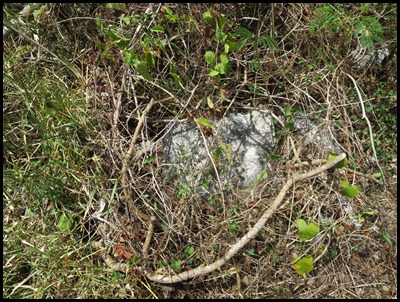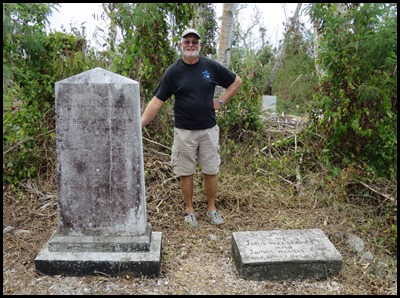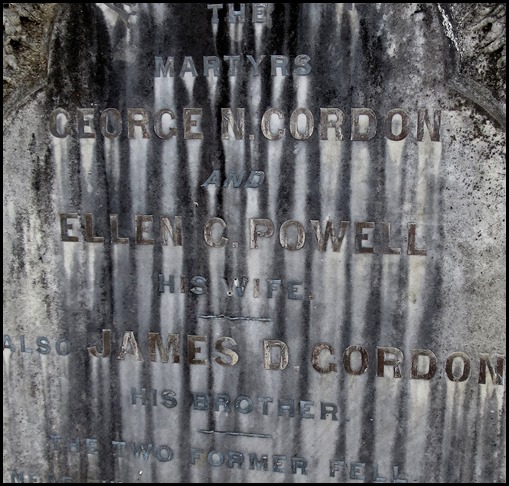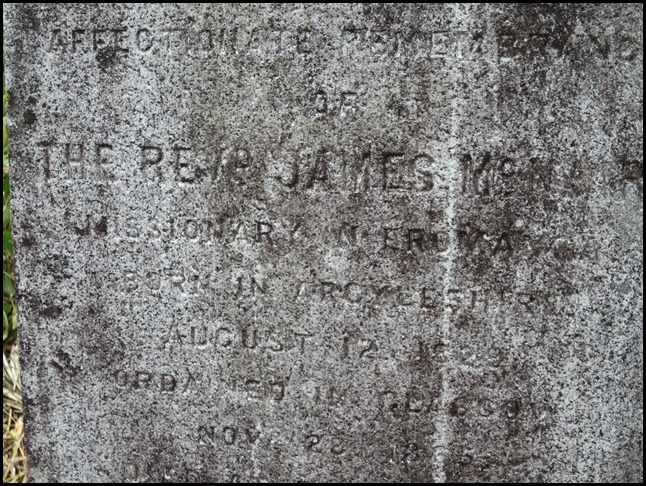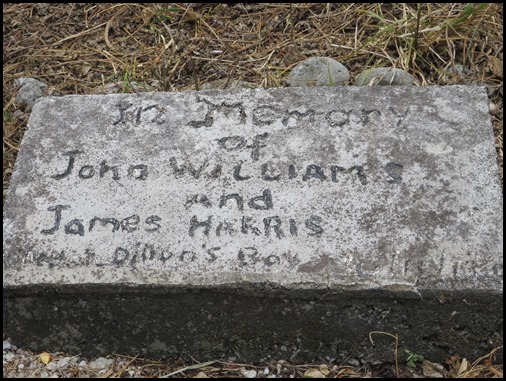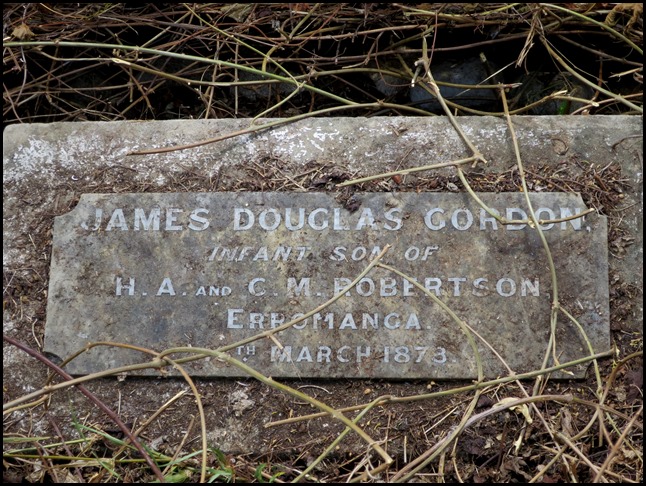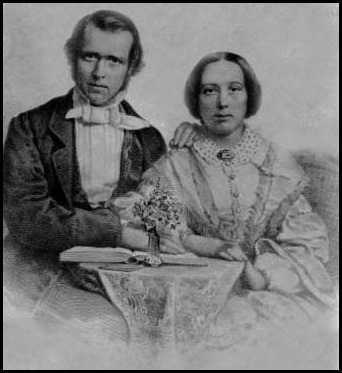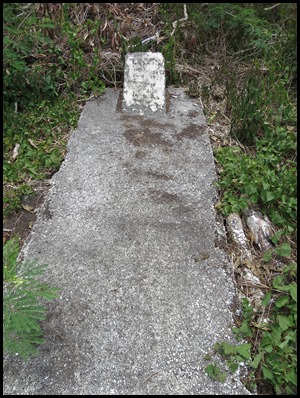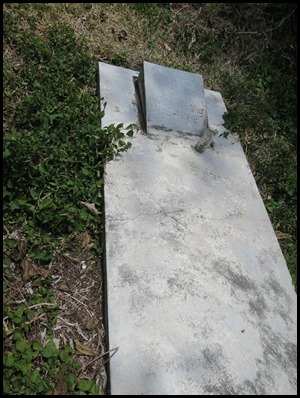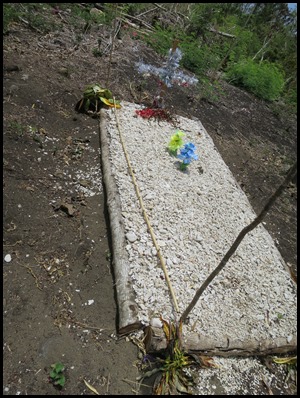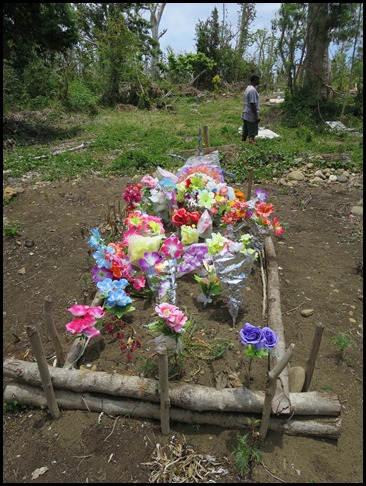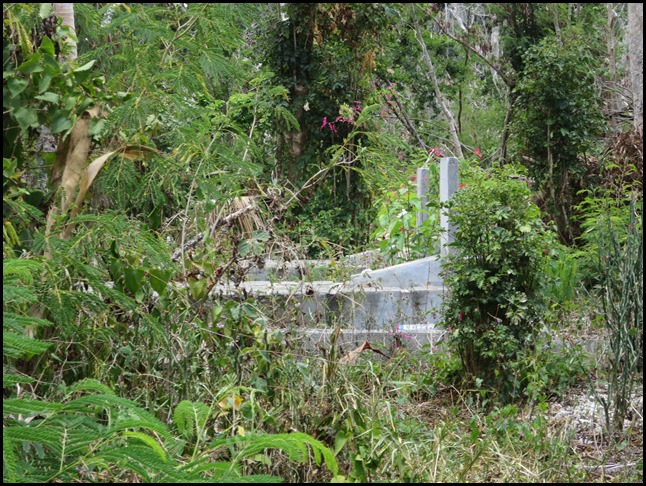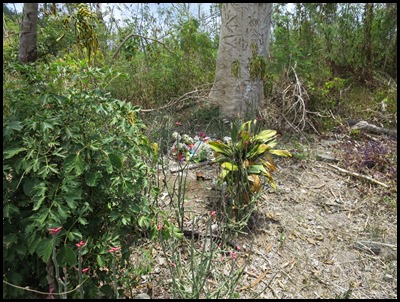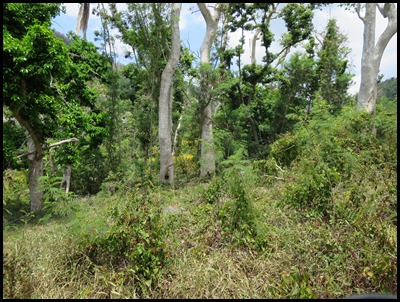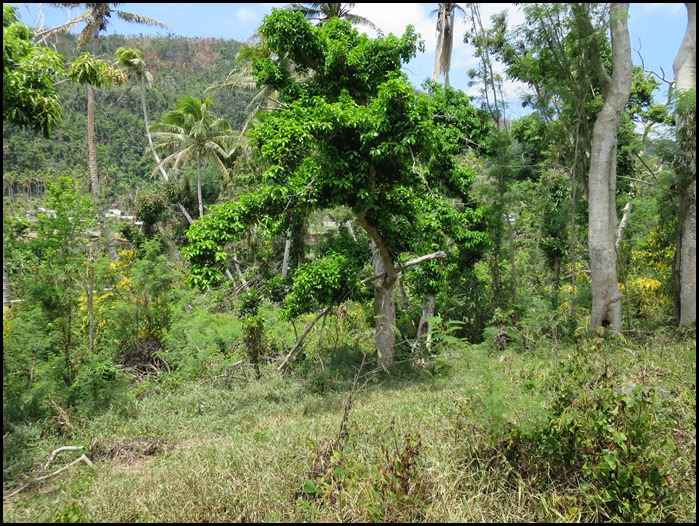Erromango Cemetery

|
Erromango
Cemetery
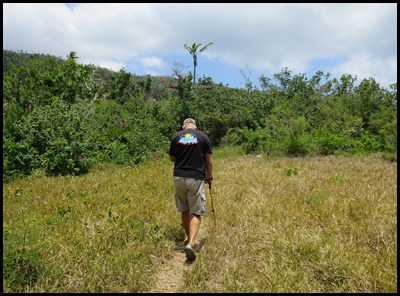 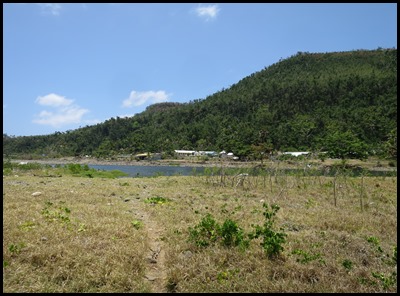 We clambered out of Baby Beez, the sun was
extremely hot as we followed Donald along a well worn
track. Looking back we could see the village on the
other side of the river.
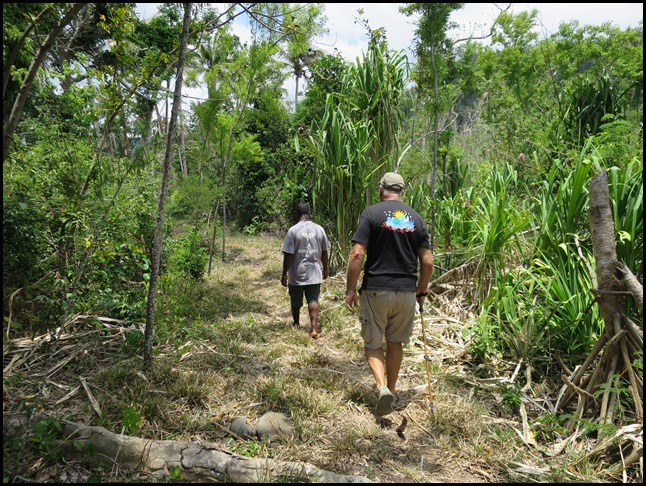 Once through low bush we began to go uphill, as we went things got more and more overgrown. Donald apologised and I sympathetically suggested that after the village was all straight post Cyclone Pam, that maybe a work party might see their way to come and do some tidying, but the next crop was the priority.
Once we were on flat ground, we began to pass a resident or two.
Two headstones and a memorial tablet were what we had come to see.
On the left of the group is the headstone of the Rev. George Nicol Gordon, of Prince Edward Island, Canada and his wife, Ellen Catherine Powell, missionaries from the Presbyterian Church of Nova Scotia to the New Hebrides, were massacred by the natives of Erromango on the 20th of May 1861. A memoir of the couple appeared in book form, at Halifax, Nova Scotia in 1863.
In the centre: The headstone belonging to James McNair. More typical were the remarks of John Geddie, pioneer Presbyterian missionary in the New Hebrides, who commented about one of his junior colleagues, James McNair: 'he is a very excellent man, but he is unfit for the hardships of missionary life.' Here is a quote from another site - The Martyr Isle lived up to its name: a further four missionaries died in the field on Erromango, either killed by tropical diseases – James McNair on the 28th of November 1860 – or murdered by local warriors – George Gordon and his wife Ellen in 1861, and George’s brother James in 1872. Finally, Hugh Angus Robertson succeeded where his predecessors had failed. He settled at Dillon’s Bay in 1872 and his Erromanga: The Martyr Isle remains the classic account of mission history on the island. However, local people have their own version of this history, passed down orally through the generations, which often provides a different perspective than that preserved in the missionary accounts.........
On the right is the memorial tablet to John Williams of the London Missionary Society [‘The Other Side’ blog] and his colleague was killed and eaten up the hill from here in 1839. We had read that in December 2009, after a lengthy collaboration between the Museum of Anthropology at the University of British Columbia and church and cultural leaders in Vanuatu, descendants of Williams travelled to Erromango to accept the apologies of descendants of those who killed their ancestor in a ceremony of reconciliation. To mark the occasion, Dillons Bay was renamed Williams Bay. Sadly, I can find nothing out about James Harris, he is just mentioned as colleague.
To the left of the group of three is a small stone with a memorial plaque to James Douglas Gordon. Infant son of H.A. and C.M. Robertson, who died in March 1873. Not sure why his last name is not Robertson and no way of finding out. Donald could shed no light and looked as if he were looking at the stone for the first time........
Rev and Mrs. Gordon - Alberton Museum collection
Text taken from the Dictionary of Canadian Biography: The Gordons set out from London for the New Hebrides on the London Missionary Society’s vessel, John Williams, at the end of July 1856. In June 1857 they reached Aneityum, where John Geddie of Nova Scotia had maintained a virtually solitary but highly successful Presbyterian mission since 1848. Finally, on about the 15th of June 1857, the Gordon’s landed at Dillon’s Bay on the island of Eromanga. There the pioneer missionary of the society, John Williams, had been killed in 1839, and the society had subsequently sent Samoan and Rarotongan teachers to prepare the way for a European missionary. During the 1840’s and 1850’s Erromango had often been visited by sandalwood traders, chiefly from Sydney; by 1857 there were several permanent trading stations, including at least one at Dillon’s Bay, not far from the site chosen for the mission settlement. During their four years in Eromanga the Gordons endured many hardships, especially Mrs Gordon’s frequent attacks of malaria which eventually necessitated the removal of the mission house to a healthier location on a nearby hill. Gordon was a powerful, energetic man, and as a skilled tradesman was particularly well qualified for the physical labour of early missionary work. With only a few native helpers he built a house, a church, and other buildings. Ten weeks after his arrival he had translated the Ten Commandments into the Eromangan dialect of Melanesian, and later translated and personally printed many other religious and educational works, including scriptural passages. He held regular services, ran a school at Dillon’s Bay, and often visited other parts of the island. Gordon wrote occasionally for the Presbyterian Witness of Halifax, edited by his friend the Reverend Robert Murray, and for the London Missionary Register. By 1861 he had won a small number of adherents on the island, who had renounced the traditional practices which the Gordons found objectionable, wore clothes, attended classes and services, and observed the Sabbath. Gordon was at first unconvinced of the value of native teachers in pioneer missionary work, and for a long time refused to train a body of local helpers. This refusal limited the range of his influence and effectiveness, and probably contributed to the misunderstandings which were to result in the Gordons’ deaths. In January 1861 a trading vessel brought people infected with measles to Dillon’s Bay [we have heard people say deliberately]. The Eromangans ignored Gordon’s warning to avoid contact with the ship, and the disease, complicated by dysentery, spread rapidly throughout the island. Many deaths and great misery followed. At about the same time a series of cyclones devastated crops and threatened famine for the survivors of the epidemic. By dispensing medicine and caring for the sick, Gordon tried to mitigate the effects of the disaster. Traditionally, Eromangans believed that disease, death, and natural disaster always resulted from sorcerers’ magic, and suspicion of sorcery immediately fell upon Gordon, who had predicted the ravages of the epidemic and who seemed immune to its effects. In mid May Gordon’s local assistants warned him to move his household back to the coast and the protection of friendly islanders. He refused. On 20 May 1861 he was ambushed at work and murdered by a group of nine Erromangans. One of the assassins then killed Mrs Gordon with his hatchet at the door of the mission house. She and her husband were both to be described as “martyrs” by Gordon’s younger brother, James Douglas, later also killed on Erromango. His The last martyrs of Eromanga . . . , attributed their deaths to the malicious influence of sandalwood traders. Several traders who were hostile to the missionaries seem indeed to have fanned the anger of some Eromangans against Gordon and his God. Gordon’s own actions, however, appear to have been at least as important. He wrote in his diary: “[The disease] was preceded by nearly a universal opposition to the gospel, and much murder and idolatry. I felt sure that God would visit them in judgment and warned them most solemnly but a few days before they were attacked. The chiefs . . . can hardly persuade their people that this is not the finger of Jehovah.” In a long letter published in the Evangelical Christendom of London on 6 April 1861, he emphasized the severity of the epidemic of measles, the growing tension, and the recent great “wickedness of this people.” Gordon’s tragedy was that the islanders regarded him as the means by which divine retribution was called down upon them. Geddie, an experienced missionary, questioned the “propriety and prudence of denouncing temporal judgment,” and considered that Gordon’s words had certainly contributed to the suspicions against him. We have been told that the chief was angered when two of his sons succumbed to measles and died, whilst Rev. Gordon was well. Others say that the chief simply feared the reverend and had him killed or that it was simply retaliation against the whiteskins who had brought so much misery to the island.
We then had a look around the rest of the cemetery, stopping to say a few words to each of the residents.
The most recent grave is that of an elderly man, his brother will join him tomorrow as he sadly died this morning.
We went to visit Chief Mede and his wife, the grandparents of Chief Jason.
As we moved about, we had to be careful where we trod, let’s face it, no worse than in so many other cemeteries we have been.
On our way back to Baby Beez Donald pointed low and to the right. Down there Lota’s dad is buried.
ALL IN ALL REALLY PLEASED WE VISITED GOOD TO SEE THE MARTYRS AND THE CHIEF
|
